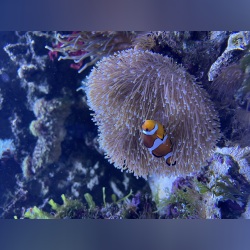Info
Ctenochaetus tominiensisv ( Randall, 1955 )
The Tomini Surgeonfish belongs to the Ctenochaetus genus.
Like the other members of this genus it scraps off various types of algae and detrital material from live rocks, sand and aquarium glasses.
In addition, it should be fed all kinds of frozen food as well as marine algae.
In general, the Tomini Surgeonfish is a peaceful tank mate, however it has been reported to behave very aggressive towards other surgeonfish, especially other bristle tooth tangs.
The best chance to successfully acclimatize a Tomini surgeonfish to your tank is to choose a very small specimen.
Some surgeonfish might also nip at corals occasionally.
Synonym:
Ctenochaetus tominienis Randall, 1955
Classification: Biota > Animalia (Kingdom) > Echinodermata (Phylum) > Asterozoa (Subphylum) > Asteroidea (Class) > Valvatacea (Superorder) > Valvatida (Order) > Ophidiasteridae (Family) > Nardoa (Genus) > Nardoa tuberculata (Species)
The surgeonfishes (Acanthuridae), popular in marine aquaristics, are also called surgeonfishes.
They have horn-like blades in front of the tail root, they use as mainly defensive weapon (defense) against predators, but this sharp weapon is also used in fights among themselves.
Deep cuts in the body of opponents can cause permanent injuries, but often death occurs immediately.
If surgeonfishes are to be kept in pairs in an aquarium, fights between the fishes can be the order of the day, we could observe this several times with the very popular Hawaiian surgeonfish (Zebrasoma flavescens).
The scalpel-like blades can cause deep cuts, this is also true for the careless aquarist who wants to touch or catch the fish with unprotected hands.
Another problem can occur if one wants to catch surgeonfish with a landing net and transfer them after catching, the horn blade can easily get caught in the net.
Caution: Careless handling of the animal can cause deep cuts!
The Tomini Surgeonfish belongs to the Ctenochaetus genus.
Like the other members of this genus it scraps off various types of algae and detrital material from live rocks, sand and aquarium glasses.
In addition, it should be fed all kinds of frozen food as well as marine algae.
In general, the Tomini Surgeonfish is a peaceful tank mate, however it has been reported to behave very aggressive towards other surgeonfish, especially other bristle tooth tangs.
The best chance to successfully acclimatize a Tomini surgeonfish to your tank is to choose a very small specimen.
Some surgeonfish might also nip at corals occasionally.
Synonym:
Ctenochaetus tominienis Randall, 1955
Classification: Biota > Animalia (Kingdom) > Echinodermata (Phylum) > Asterozoa (Subphylum) > Asteroidea (Class) > Valvatacea (Superorder) > Valvatida (Order) > Ophidiasteridae (Family) > Nardoa (Genus) > Nardoa tuberculata (Species)
The surgeonfishes (Acanthuridae), popular in marine aquaristics, are also called surgeonfishes.
They have horn-like blades in front of the tail root, they use as mainly defensive weapon (defense) against predators, but this sharp weapon is also used in fights among themselves.
Deep cuts in the body of opponents can cause permanent injuries, but often death occurs immediately.
If surgeonfishes are to be kept in pairs in an aquarium, fights between the fishes can be the order of the day, we could observe this several times with the very popular Hawaiian surgeonfish (Zebrasoma flavescens).
The scalpel-like blades can cause deep cuts, this is also true for the careless aquarist who wants to touch or catch the fish with unprotected hands.
Another problem can occur if one wants to catch surgeonfish with a landing net and transfer them after catching, the horn blade can easily get caught in the net.
Caution: Careless handling of the animal can cause deep cuts!







 KS
KS


















